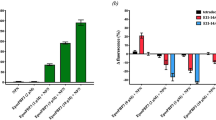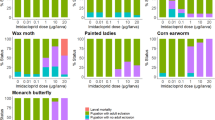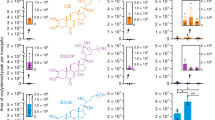Abstract
The ecdysteroid hormones coordinate the major stages of insect development, notably moulting and metamorphosis, by binding to the ecdysone receptor (EcR); a ligand-inducible nuclear transcription factor1,2. To bind either ligand or DNA, EcR must form a heterodimer with ultraspiracle (USP), the homologue of retinoid-X receptor3,4,5. Here we report the crystal structures of the ligand-binding domains of the moth Heliothis virescens EcR–USP heterodimer in complex with the ecdysteroid ponasterone A and with a non-steroidal, lepidopteran-specific agonist BYI06830 used in agrochemical pest control. The two structures of EcR–USP emphasize the universality of heterodimerization as a general mechanism common to both vertebrates and invertebrates. Comparison of the EcR structures in complex with steroidal and non-steroidal ligands reveals radically different and only partially overlapping ligand-binding pockets that could not be predicted by molecular modelling and docking studies6,7. These findings offer new perspectives for the design of insect-specific, environmentally safe insecticides. The concept of a ligand-dependent binding pocket in EcR provides an insight into the moulding of nuclear receptors to their ligand, and has potential applications for human nuclear receptors.
This is a preview of subscription content, access via your institution
Access options
Subscribe to this journal
Receive 51 print issues and online access
$199.00 per year
only $3.90 per issue
Buy this article
- Purchase on Springer Link
- Instant access to full article PDF
Prices may be subject to local taxes which are calculated during checkout



Similar content being viewed by others
References
Koelle, M. R. et al. The Drosophila EcR gene encodes an ecdysone receptor, a new member of the steroid receptor superfamily. Cell 67, 59–77 (1991)
Riddiford, L. M., Cherbas, P. & Truman, J. W. Ecdysone receptors and their biological actions. Vitam. Horm. 60, 1–73 (2001)
Yao, T.-P., Segraves, W. A., Oro, A. E., McKeown, M. & Evans, R. M. Drosphila ultraspiracle modulates ecdysone receptor function via heterodimer formation. Cell 71, 63–72 (1992)
Thomas, H. E., Stunnenberg, H. G. & Stewart, A. F. Heterodimerization of the Drosophila ecdysone receptor with retinoid X receptor and ultraspiracle. Nature 362, 471–475 (1993)
Yao, T.-P. et al. Functional ecdysone receptor is the product of EcR and ultraspiracle genes. Nature 366, 476–479 (1993)
Wurtz, J.-M. et al. A new model for 20-hydroxyecdysone and dibenzoylhydrazine binding: A homology modeling and docking approach. Protein Sci. 9, 1073–1084 (2000)
Kasuya, K. et al. Binding mode of ecdysone agonists to the receptor: comparative modeling and docking studies. J. Mol. Model. 9, 58–65 (2003)
Dhadialla, T. S., Carlson, G. R. & Le, D. P. New insecticides with ecdysteroidal and juvenile hormone activity. Annu. Rev. Entomol. 43, 545–569 (1998)
Toya, T., Fukasawa, H., Masui, A. & Endo, Y. Potent and selective partial ecdysone agonist activity of chromafenozide in Sf9 cells. Biochem. Biophys. Res. Commun. 292, 1087–1091 (2002)
Gampe, R. T. Jr et al. Asymmetry in the PPARγ/RXRα crystal structure reveals the molecular basis of heterodimerization among nuclear receptors. Mol. Cell 5, 545–555 (2000)
Bourguet, W. et al. Crystal structure of a heterodimeric complex of RAR and RXR ligand-binding domains. Mol. Cell 5, 289–298 (2000)
Svensson, S. et al. Crystal structure of the heterodimeric complex of LXRα and RXRβ ligand-binding domains in a fully agonistic conformation. EMBO J. 22, 4625–4633 (2003)
Billas, I. M. L., Moulinier, L., Rochel, N. & Moras, D. Crystal structure of the ligand binding domain of the ultraspiracle protein USP, the ortholog of RXRs in insects. J. Biol. Chem. 276, 7465–7474 (2001)
Clayton, G. M., Peak-Chew, S. Y., Evans, R. M. & Schwabe, J. W. The structure of the ultraspiracle ligand-binding domain reveals a nuclear receptor locked in an inactive conformation. Proc. Natl Acad. Sci. USA 98, 1549–1554 (2001)
Horlein, A. J. et al. Ligand-independent repression by the thyroid hormone receptor mediated by a nuclear receptor co-repressor. Nature 377, 397–404 (1995)
Rochel, N., Wurtz, J.-M., Mitschler, A., Klaholz, B. P. & Moras, D. The crystal structure of the nuclear receptor of vitamin D bound to its natural ligand. Mol. Cell 5, 173–179 (2000)
Henrich, V. C. & Brown, N. E. Insect nuclear receptors: A developmental and comparative perspective. Insect Biochem. Mol. Biol. 25, 881–897 (1995)
Gilbert, L. I., Rybczynski, R. & Warren, J. T. Control and biochemical nature of the ecdysteroidogenic pathway. Annu. Rev. Entomol. 47, 883–916 (2002)
Baker, K. D., Warren, J. T., Thummel, C. S., Gilbert, L. I. & Mangelsdorf, D. J. Transcriptional activation of the Drosophila ecdysone receptor by insect and plant ecdysteroids. Insect Biochem. Mol. Biol. 30, 1037–1043 (2000)
Mohammed-Ali, A. K., Chan, T.-H., Thomas, A. W., Strunz, G. M. & Jewett, B. Structure-activity relationship study of synthetic hydrazines as ecdysone agonists in the control of spruce budworm (Choristoneura fumiferana). Can. J. Chem. 73, 550–557 (1995)
Hu, X., Cherbas, L. & Cherbas, P. Transcription activation by the ecdysone receptor (EcR/USP): Identification of activation functions. Mol. Endocrinol. 17, 716–731 (2003)
Kumar, M. B., Fujimoto, T., Potter, D. W., Deng, Q. & Palli, S. R. A single point mutation in ecdysone receptor leads to increased ligand specificity: Implications for gene switch applications. Proc. Natl Acad. Sci. USA 99, 14710–14715 (2002)
Farnegardh, M. et al. The three dimensional structure of the liver X receptor beta reveals a flexible ligand binding pocket that can accommodate fundamentally different ligands. J. Biol. Chem. 40, 38821–38828 (2003)
Arbeitman, M. N. & Hogness, D. S. Molecular chaperones activate the Drosophila ecdysone receptor, an RXR heterodimer. Cell 101, 67–77 (2000)
Egea, P. F. et al. Crystal structure of the human RXRα ligand-binding domain bound to its natural ligand 9-cis retinoic acid. EMBO J. 19, 2592–2601 (2000)
Kissinger, C. R., Gehlhaar, D. K. & Fogel, D. B. Rapid automated molecular replacement by evolutionary search. Acta Crystallogr. D 55, 484–491 (1999)
Brünger, A. T. et al. Crystallography & NMR system: A new software suite for macromolecular structure determination. Acta Crystallogr. D 54, 905–921 (1998)
Jones, T. A., Zou, J. Y., Cowan, S. W. & Kjeldgaard, M. Improved methods for building protein models in electron density maps and the location of errors in these models. Acta Crystallogr. A 47, 110–119 (1991)
Greiner, E. F. et al. Functional analysis of retinoid Z receptor beta, a brain-specific nuclear orphan receptor. Proc. Natl Acad. Sci. USA 93, 10105–10110 (1996)
Potier, N. et al. Using non denaturing mass spectrometry to detect fortuitous ligands in orphan nuclear receptors. Protein Sci. 12, 725–733 (2003)
Acknowledgements
We are grateful to G. Holmwood, K. Tietjen and M. Schindler (Bayer CropScience) for providing us with BYI06830 and ponA. We thank H. Greschik, H. Gronemeyer, B. Klaholz and G. Richards for critical comments on the manuscript; Y. Brelivet and J. M. Wurtz for discussion and advice; H. Nierengarten for mass spectrometry analysis; V. Chavant, D. Rose and F. Zink for technical assistance; S. Sasorith for her help with figures; and C. Massobrio for support and encouragement. We thank the staff of the ESRF ID14 beamline (Grenoble, France) and of the French beamline BM30A (Grenoble, France) for assistance during synchrotron data collection. This work was supported by Bayer CropScience and by grants from CNRS, INSERM, the Hôpital Universitaire de Strasbourg, the Ministère de la Recherche et de la Technologie (Programme de Génomique Structurale) and EU-SPINE.
Author information
Authors and Affiliations
Corresponding author
Ethics declarations
Competing interests
The authors declare that they have no competing financial interests.
Supplementary information
41586_2003_BFnature02112_MOESM1_ESM.pdf
Supplementary Figure 4: Composed of three panels (a) electrostatic potential surface (b) dose-dependence of the transactivational activity of the wild-type and the quadruple-mutant hvEcR-LBD/hvUSP and (c) electrospray ionization mass-spectra for the wild-type and the quadruple-mutant hvEcR-LBD/hvUSP. (PDF 1611 kb)
Rights and permissions
About this article
Cite this article
Billas, I., Iwema, T., Garnier, JM. et al. Structural adaptability in the ligand-binding pocket of the ecdysone hormone receptor. Nature 426, 91–96 (2003). https://doi.org/10.1038/nature02112
Received:
Accepted:
Published:
Issue Date:
DOI: https://doi.org/10.1038/nature02112
This article is cited by
-
Eco-friendly synthesis of substituted tetrahydroquinolines as potential ecdysone receptor agonists
Chemical Papers (2023)
-
Ecdysteroids: isolation, chemical transformations, and biological activity
Phytochemistry Reviews (2022)
-
Ingestion of bacteria expressing dsRNA to maggots produces severe mortality and deformities in fruit fly, Bactrocera dorsalis (Hendel) (Diptera: Tephritidae)
Egyptian Journal of Biological Pest Control (2021)
-
Genome-wide Identification of Tebufenozide Resistant Genes in the smaller tea tortrix, Adoxophyes honmai (Lepidoptera: Tortricidae)
Scientific Reports (2019)
-
EcR recruits dMi-2 and increases efficiency of dMi-2-mediated remodelling to constrain transcription of hormone-regulated genes
Nature Communications (2017)
Comments
By submitting a comment you agree to abide by our Terms and Community Guidelines. If you find something abusive or that does not comply with our terms or guidelines please flag it as inappropriate.



